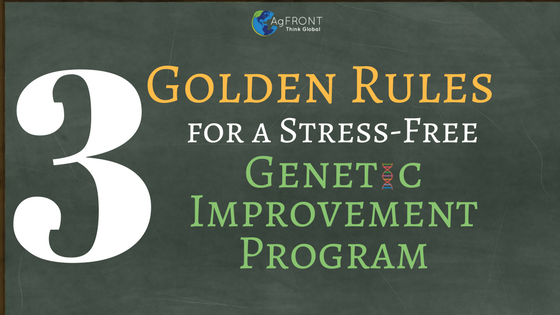Ever since the use of agrigenomics-based tests (a.k.a DNA tests) went mainstream, more and more organizations are looking at the idea of incorporating these services and products into their genetic improvement programs.
Early adopters of any technology always pave the way for the rest of the industry. Their growing pains and mistakes along the way serve as lessons learned and as a framework for kick-starting other programs.
It’s no easy task bringing in a new technology to an organization or industry. It requires serious commitment and preparation to weather the storm of “we’ve always done it this way”.
Companies that spend time on the planning phase, seeking out to understand the scope of the program, researching and aiming before firing can save significant time, money and not to mention stress when it’s finally time to pull the trigger.
If you are in search of real solutions and guidance when it comes to implementing routine DNA testing in a genetic improvement program, then you need to read these 3 golden rules:
1 – Parentage Testing (Verification) is the first step
One of the pillars for a well-structured genetic improvement program lies in having the correct pedigree in place.
There can be no GE-EPDs, GE-PTAs or GE-EBVs without properly calculating EPDs, PTAs or EBVs. The traditional EPDs/PTAs/EBVs (a.k.a not genomically enhanced) are calculated when you have access to the following sources of information: performance, pedigree and progeny. When you add genomics (DNA) information, we tend to call them GE-EPDs/PTAs/EBVs.
Parentage testing will take care of getting your database structured with the correct pedigree (which means figuring out who the real relatives are, including progeny). The genomics (DNA) part that I referred to earlier is obtained when we use what the industry calls the full genomic profile (the "high-density" chips that we hear about: 50k and others).
A full genomic profile (50k and others) can hold many tests including parentage, genetic defects and many other markers used to predict the traits of interest. It's the type of panel that you use when you have your "ducks in a row" and when you are ready to beef up (pun intended) your genetic improvement program.
If all you need is to get your database structured with the correct pedigree, then I would recommend that you use a simple and standalone parentage test. Currently, cattle parentage tests** range from 100 (taurus) to 200 (indicus) SNPs - International Society of Animal Genetics (ISAG) recommendations, which I highly recommend you follow, particularly if you want to do business (set up a laboratory, sell genetic tests or sell genetics) in Latin America, Brazil or Europe - and it should cost no more than USD $20 dollars per sample, at the 200-SNP panel level. **
In fact, you will find it for much less when you search for more options and back it up with volume. Check out some of the options available in the industry by downloading the "Step-by-Step Guide To Parentage Testing".
**Warning: If you are not keeping good records of your bull battery and breeding groups, even at the 200-SNP level, you are likely to have issues finding the true sire**.
The problem with using a full genomic profile if you don't yet have your database structured correctly is that you would be paying around USD $50 per sample (it could be less if you choose to go with less markers and have volume) for parentage testing.
While, it's fun to build your database with genotypes, it's even better to build it with genotypes (and phenotypes) that will actually be useful for your program at this point in time, particularly if you are an organization strapped for cash.
Using a full genomic profile when all you need is a simple parentage test would translate into spending more than you need to. You would also be genotyping animals that are likely not the best source to get you started with genomically enhanced EPDs/PTAs/EBVs.
I underlined and bolded “get you started” for a reason. While one of the objectives of using genomics is to eventually select animals that do not have phenotypic data (this is what we call "to practice genomic selection"), in order to get to the promised land, you still need a starting database of animals with solid phenotypic data.
*******************************************************************************************************************************
Are you a company in the animal, crop or plant industry? ASK ME how to properly manage the integration of genomics (DNA testing) technology in your organization.
*******************************************************************************************************************************
In order to get to the promised land, you still need a starting database of animals with solid phenotypic data. - Elisa Marques @AgFRONT
Parentage testing (verification) will allow your organization to fix any pedigree issues and set the proper foundation for finding the most appropriate animals for kickstarting your genetic improvement program.
For Breed Associations or Societies that have never used any type of DNA testing before, I would not recommend that you worry about using a full genomic profile or get bogged down about calculating GE-EPDs at this point.
I am not recommending that organizations sit around wondering if GE-EPDs are worth “getting into” (The Future of the Breed Associations). I am recommending that the first step be to “arrange” the database and then to select those animals that are worth genotyping with a higher (and more expensive) panel.
Related: The Future of the Breed Associations
Start with parentage verification and perhaps genetic defect testing, if that applies to your organization.
Here are some additional reasons:
1) Your membership still needs to get used to the idea of ordering a test and receiving results that are new to them.
2) You will need time to train your internal staff on best practices and how to handle those customer service calls.
3) You will have to work out the kinks in establishing this new workflow with your laboratory or laboratories of choice. This will take some time.
2 – Choose Your Laboratory Like You Would Choose Your Spouse
There is an increasing number of service providers out there. That’s great. It allows for some competition. Some will invite you over for a “cup of coffee” all expenses paid, and “we have a nice little contract for you to sign”.
I have listed several genomics laboratories in the Parentage Testing E-book. Make sure to download the guide.
Here is my analogy when choosing a laboratory to work with. It’s like choosing your spouse. Not a friend. If my friend consistently messes up, blames me for their lack of responsibility and ownership…well, I can cut ties with my friend. Bye.
Now, a laboratory or service provider, that’s more like marriage. When things are great, everyone is happy. When things are not great, you start talking about divorce and who gets the samples and the data.
You need a Prenup. A good one.
So, before you put a ring on its finger, you can and should ask around before you send any of your samples to any laboratory.
Be particularly aware of changes in ownership of the laboratory that you were once sending your samples to. It will now be under different management and operation.
If you are unsure what that will mean for you, my best advice would be to ask around in the industry and to hire legal counsel.
Most organizations want to choose a service provider because they are attracted to the cheaper prices of a test. After all, genotyping costs can sometimes be over 50% of the total cost of the project. Neglecting to look at the overall scope of the business that you are "partnering" with and not putting in place checks and balances to help guarantee a stress-free program can end-up being a pretty expensive "bill" to pay in the future.
Don't forgo your company's long-term success for a great price on a test or for the fact that it's easier to send the samples directly to the laboratory. Remember, you get what you pay for. There is no such thing as a free lunch.
Don't forgo your company's long-term success for a great price on a test, or for the fact that it's easier to send the samples directly to the laboratory - Elisa Marques @AgFRONT
Consider adding more than one supplier to your list. Unlike a real marriage, you won’t get penalized for two-timing here. "Date" around before you settle down. If you feel that you are getting pressured to sign an exclusive agreement or you are not getting the services that you need, be sure to hit up the other options in town.
What does the contract say? Who do the samples and data belong to? Can any of that be used for product development without your consent? If you are sending samples with information that can be matched to public phenotypic records, it can be hard to stop that after the fact. Don't be naive to think that you can put the Genie back in the bottle.
*******************************************************************************************************************************
Are you a laboratory servicing the Agriculture Biotechnology Industry and interested in setting up the right workflow and business in your local market? ASK ME how you can properly develop the market for your service.
*******************************************************************************************************************************
Don't be naive to think that you can put the Genie back in the bottle - Elisa Marques @AgFRONT #Data #Genetics #Genomics
This is a situation that every organization needs to be aware of, not just those that are starting to get in the game. If you don’t want to worry about this, then you need to build your own laboratory.
If you can't afford a laboratory just yet, then look at the simple things that I talked about earlier in the article. Invest your money in changing these processes.
Find a laboratory that wants to be a laboratory focused on operational excellence. A successful genetic improvement program requires excellent turnaround time.
3 – Have a Communication Plan That Includes Training
A communication plan cannot be emphasized enough in any technology implementation program. There is a lot happening internally and the stakeholders need to be aware of how those changes will impact them.
I guarantee you that once you start putting in place routine parentage testing for your membership, you will have a lot of questions as to why this bull or that bull didn’t qualify.
Which will usually be followed by “this doesn’t work.”
Can you imagine offering a genomic profile on top of parentage testing and then realizing that you forgot to explain what EPDs are and how to use them?
Related: Breeds United: Together is Better
So, how will your Organization handle those questions? That’s where communication and training comes in.
Think about this. If you have never done something before, it takes time to get you warmed up to it. Maybe visit the website several times. Google the terms.
And if your organization’s website doesn’t have the information your customers need or it’s hard to navigate, your job in communicating that information and process just became 10X harder.
So, avoid jam packing the submission form with a number of genomics tests. The more options you have on your submission form, the less effective the transition to a new program will be.
The more options you have on your submission form, the less effective the transition to a new program will be. - Elisa Marques @AgFRONT
Inexperienced people will say to just peel off the BandAid. Maybe squeeze another change in there and nobody will notice it. This tactic has already been tried when genomics companies introduced genomics tests using SNP technology (>10 years ago) when many Associations were still using microsatellites for parentage.
You cannot shortcut training and development, because when you do, both the technology and the local markets suffer. The proper strategy is to have a communication plan that includes training.
*******************************************************************************************************************************
Are you a company in the animal, crop or plant industry? ASK ME how to properly manage the integration of genomics (DNA testing) technology in your organization.
*******************************************************************************************************************************
You cannot shortcut training and development, because when you do, both the technology and the local markets suffer. - Elisa Marques @AgFRONT
Related: The Future of the Breed Associations
A communication and training plan is not an email blast with frequently asked questions. A communication and training plan is a well-thought-out strategy with an action plan of how you will be communicating your message and how you will train those using the technology.
Remember that not everyone will be listening to your message the first, or second time, nor will everybody understand it. It’s important that you establish clear guidelines and expectations with those involved in the process, especially the laboratory.
Think of your customers as your company’s personal army of extensionists. If they know what’s going on and how to use the tools that you are making available for them, they are much more inclined to use them and to teach others how to use them.
Related: The Path To A Successful Technology Commercialization
Final Thoughts:
Over the years, the lucky few have really witnessed and learned the lessons and processes required to successfully implement a change (whether it’s adding a new trait, a new index or implementing genomics) into genetic improvement programs.
Having participated in the development of the original Bovine Chip: The Illumina Bov50k, managed its use in a breed improvement program and witnessed first-hand when laboratories got flooded with samples (Read: Breeds United: Together is Better), I can say, with certainty, that when all the parties involved (laboratories, breed associations, genetic evaluation companies, technology companies and breeders) do not spend time planning these changes, it affects the customers, the staff and the product(s) that you are trying to sell.
Organizations should not expect the laboratory to take care of the internal technology implementation or change. Laboratories are genotyping service providers. The onus should not be on them to manage breed improvement programs and to build genomics products.
Related: How to Develop AgriGenomics Products and Get the Best Prices
The idea is to bring sustainable change to your organization and to transform it into a fully functional system that adds value to your membership and to their customers. To pay for those changes, you will need to transform its not-for-profit mindset into a business mindset.
That will take some time, but it’s not impossible.



One should also think of developing a robust SNP quality control program. Farmers will tag the wrong animal, labs will swap samples, the wrong sex or breed will be recorded. A well planned QC pipeline can identify and fix these errors. Also consider using 500 or more parentage SNP to allow for parentage prediction
Yes. Agreed. The current parentage panels that I mentioned in the article are definitely insufficient to mitigate all of those risks involved in implementing a robust AgriGenomics Program. I sure hope ISAG can make new recommendations very soon. Thank you for all the work you’ve done trying to demonstrate how important it is to have the right panel. The industry thanks you!